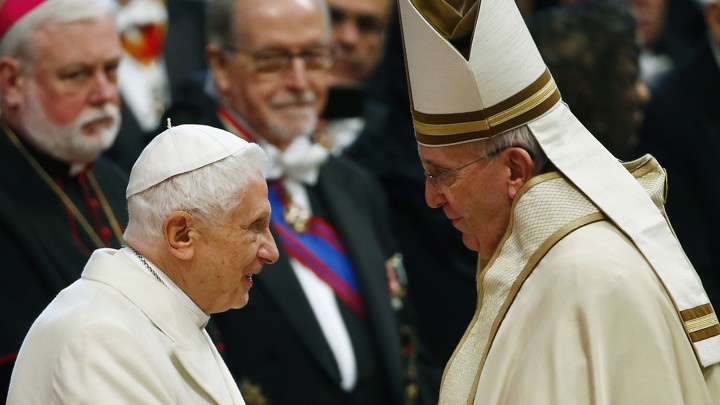Benedict, the pope emeritus, weighed in on the Catholic Church’s abuse crisis. What was once opaque becomes clearer, and even stranger.
Apr 12, 2019

Pope Francis greets Pope Emeritus Benedict XVI.Tony Gentile / Reuters
VATICAN CITY—Popes are supposed to be infallible. They communicate through carefully worded speeches, apostolic letters, or encyclicals that are often the fruit of slow collaboration with doctrinal experts inside the Vatican. So what are we to make of the strange text that Benedict XVI, the pope emeritus, unleashed on the world this week, in which he effectively blamed the abuse crisis in the Catholic Church on the freewheeling sexual revolution of 1968?
Before we get into the contents of Benedict’s letter—which is informal, not Church doctrine—let us pause for a moment to consider the utter weirdness of the situation. In 2013, Benedict, who turns 92 next week, became the first pope in modern history to resign. It was a brave and rather beautiful act that defined his life and the modern history of the Church. Since then, he’s lived in retirement inside Vatican City—reading, writing, playing a little piano.
Benedict pledged to stay in the background and lead a life of quiet contemplation, and to not meddle in the affairs of his successor, Francis. Instead, he has weighed in on one of the most fraught issues of both their papacies, in a way that’s bumbling, tone-deaf, and theologically problematic. (Theologians have also pointed out that this kind of document isn’t subject to the doctrine of papal infallibility.)
Especially since it comes just months after the Vatican held a summit of bishops from around the world to address the sexual-abuse crisis. Bishops heard the painful testimony of victims who’d been abused by priests, and Francis called for concrete action. The conference was seen as a step forward, even if victims’-rights organizations said that it didn’t go far enough, and that it confirmed their sense that they’ve found a clearer response through civil justice.
Read: The “Spotlight” effect: This Church scandal was revealed by outsiders
Benedict didn’t stay in the background. Instead, he published a letter that is incoherent, inaccurate, and at times truly bizarre. In his letter, he wrote that the news of the February conference had compelled him to action. “I compiled some notes by which I might contribute one or two remarks to assist in this difficult hour,” he wrote.
Benedict alerted Francis that he’d be publishing the letter, but I can’t begin to imagine how Francis responded.
In his letter, Benedict blamed the sexual-abuse crisis on the absence of God. This is a theological argument that’s worth hearing out, although one could argue that, say, human agency was also to blame for a crisis in which priests sexually abused minors and dioceses routinely covered up the abuse.
I still remember seeing, as I was walking through the city of Regensburg one day, crowds of people lining up in front of a large cinema, something we had previously only seen in times of war, when some special allocation was to be hoped for. I also remember arriving in the city on Good Friday in the year 1970 and seeing all the billboards plastered up with a large poster of two completely naked people in a close embrace.
Among the freedoms that the Revolution of 1968 sought to fight for was this all-out sexual freedom, one which no longer conceded any norms.
The mental collapse was also linked to a propensity for violence. That is why sex films were no longer allowed on airplanes because violence would break out among the small community of passengers. And since the clothing of that time equally provoked aggression, school principals also made attempts at introducing school uniforms with a view to facilitating a climate of learning.
This is not just the free association of the average nonagenarian; these are the observations of the pope emeritus, the man who led a church of 1 billion people from 2005 to 2013, and who before that was its top doctrinal enforcer. Also: Violence on planes? What is he talking about?
In his letter, Benedict said the crisis became most acute in the second half of the 1980s. This is not quite the case. He himself, as prefect for the Congregation for the Doctrine of the Faith, the Vatican’s doctrinal office, handled abuse cases sent to the Vatican dated before then. He also managed an investigation into the Legionaries of Christ and its charismatic Mexican founder, the Reverend Marcial Maciel Dellogado, who was later found to have molested seminarians and fathered several children well before the ’80s. (He left the Legionaries out of the letter.)
In 2010, a new round of the sexual-abuse crisis erupted on Benedict’s watch, and questions were raised about how he had handled abuse cases when he was the archbishop of Munich and then the head of the Vatican’s doctrinal office. What did the pope really think about the abuse crisis?, many of us following the story then wondered. Now, eight years later, we know. (That’s actually quite fast by Vatican standards.) The problem is that his private observations undermine some of his official statements on the matter.
Read: The power play driving the latest Vatican crisis
Why did Benedict even publish this thing? Benedict’s longtime personal secretary, Monsignor Georg Gänswein, told The New York Times that the pope had published his reflections of his own accord. The letter appeared in several archconservative outlets that have been critical of Francis and that also published a bombshell letter last summer in which an archbishop said the Vatican was full of “gay lobbies.”
From afar, the Vatican is seen as an impenetrable and mysterious world, a place of ancient, sacred rituals and quiet religiosity. Inside, it turns out it’s a bureaucracy like any other. Sometimes the former boss weighs in, and what was once opaque becomes clearer, and even stranger.
Source
No comments:
Post a Comment